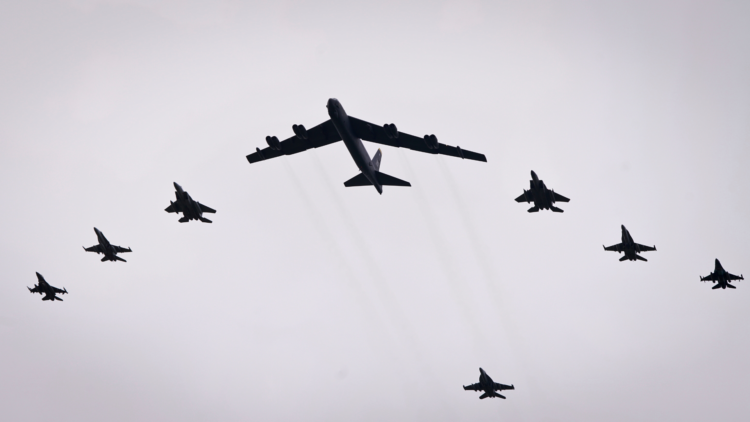A Strategic Alliance Takes Flight
In the chess game of global power, the US and Japan are pushing their pawns forward, eyeing the Indo-Pacific board with a keen, unwavering gaze.
The play? A bold venture into the realm of next-gen drones, a move that’s setting the stage for a seismic shift in military muscle in these tumultuous waters.
Spearheaded by the top brass, this alliance is more than a handshake; it’s a testament to the critical need for a tech-driven edge in an arena where the rules of engagement are being rewritten.
At the heart of this pact is a clear-eyed view of the dragon in the room—China.
With Beijing pumping iron into its air defense, the skies over the Western Pacific are thick with tension, a high-stakes game where traditional manned birds are increasingly caught in the crosshairs.
In response, Uncle Sam’s Air Force, along with its brethren from the Land of the Rising Sun, is betting big on the ace up their sleeve: autonomy, artificial intelligence (AI), and the silent warriors of the sky.
CCAs: The Ghost Squadron of the Future
Enter the Collaborative Combat Aircraft (CCA) project, a groundbreaking leap into the future of warfare.
These aren’t your granddad’s drones (if he had drones); they’re the next evolution, poised to take on everything from recon to full-blown electronic warfare.
Japan will participate in an American program to develop next-generation drones known as collaborative combat aircraft "at some point," U.S. Secretary of the Air Force Frank Kendall told Nikkei Asia. https://t.co/R0nQwIDKuK
Advertisement— Nikkei Asia (@NikkeiAsia) January 25, 2024
With AI at the helm, these unmanned aces can dodge the bullet, minimizing the flesh-and-blood risk and ramping up the odds of mission success.
Though the blueprint bears the stamp of US contractors, make no mistake—Japan’s not just riding shotgun.
“What we’re planning is a program of increasing performance over time,” said Frank Kendall, US Air Force Secretary, quoted by Nikkei Asia. “we’re going to continue to mature this technology and advance it in additional increments.”
They’re in the cockpit, a co-pilot in this high-octane flight into the future.
It’s a partnership forged in steel and silicon, a melding of American know-how and Japanese tech prowess that’s set to redefine the art of aerial combat.
Deep Strategic Synchronization
But this alliance is playing the long game, looking beyond the CCA.
AI and machine learning—it’s all on the table, a full deck of high-tech tricks that are reshaping the way Uncle Sam and his allies watch over the seas.
It’s a deep, strategic sync, a shared vision for keeping the peace in a neighborhood that’s looking more like a powder keg with each passing day.
I can now confirm Anduril as one of five vendors for Collaborative Combat Aircraft (CCA), the Air Force's flagship autonomous aircraft program.
As the only non-traditional company selected, we commend Secretary Kendall and the USAF for their commitment to new technology. pic.twitter.com/FVDOclQOwl
— Palmer Luckey (@PalmerLuckey) January 25, 2024
The stakes are sky-high in the Indo-Pacific theater, where every move is magnified, every alliance scrutinized.
In this high-stakes milieu, the CCA project is more than hardware; it’s a statement, a line drawn in the sand.
It’s about holding the line, about ensuring that the waves of change don’t erode the pillars of stability in these pivotal waters.
Charting the Future: A Fleet of Unmanned Warriors
As the horizon draws closer, the path charted by this US-Japan tech tango spells out a future where unmanned warriors of the sky are the norm, not the exception.
With a fleet of 1,000 CCAs on the drawing board, it’s clear that we’re on the brink of a revolution, one that’s set to redefine the theater of war.
“I think there is a lot of technical capability that Japan can bring to the table and that we can all benefit from working together,” Kendall noted. “I’m hopeful that we’ll find ways to do that and expand beyond some of the things that we’re doing now in the technology area.”
In wrapping this up, let’s cut to the chase: this isn’t just another defense deal.
It’s a clarion call, a rally to arms in the face of shifting sands and rising tides.
As these two nations lock arms and look ahead, their sights set on a horizon brimming with challenges and opportunities, their alliance stands as a bastion of resolve, a joint commitment to navigate the stormy seas of a new era in geopolitical strife.
And as they chart this course together, their partnership lights the way, a beacon of innovation and unity in a world where the only constant is change.










COMMENTS
You must become a subscriber or login to view or post comments on this article.